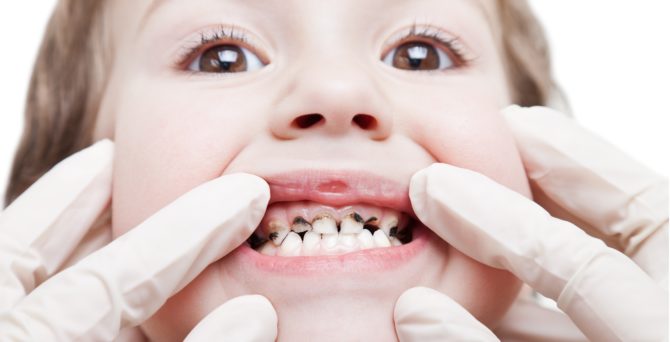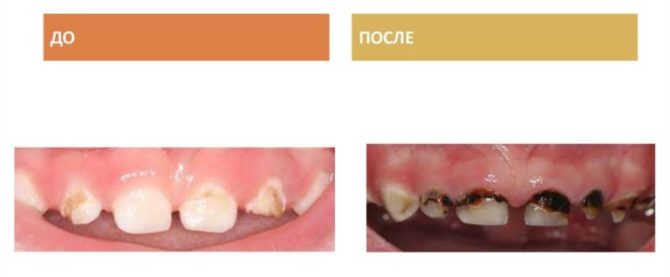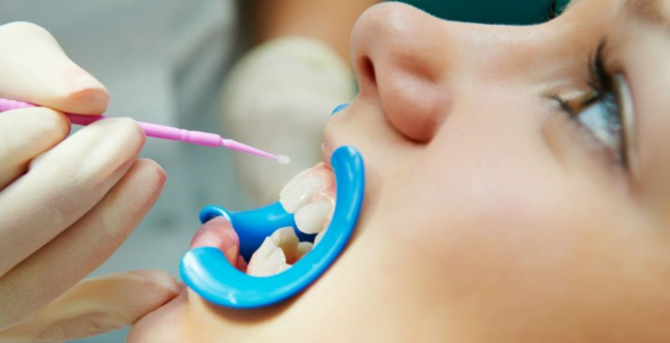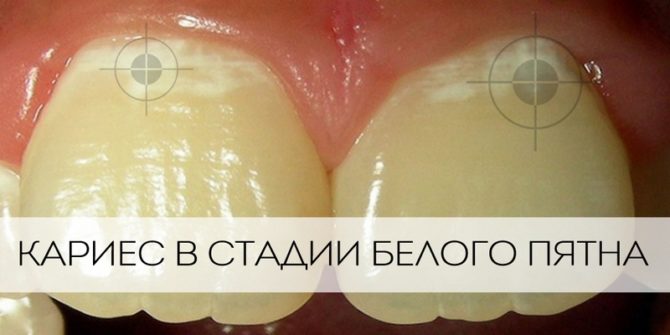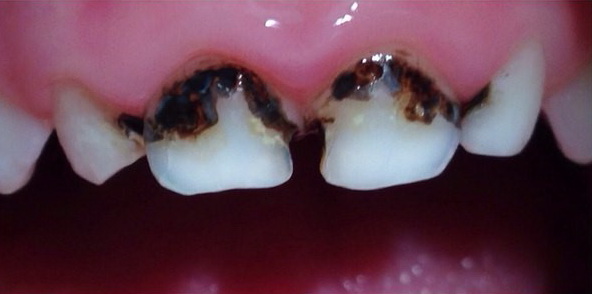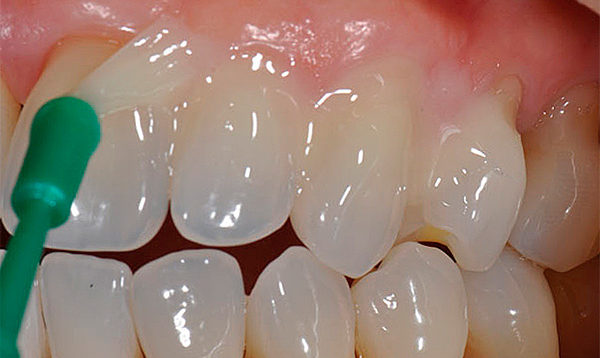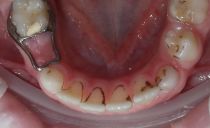Silvering of teeth in children: why is it necessary, indications, methods of silvering of primary teeth
Many mistakenly believe that it is not necessary to treat milk teeth and care for them, since they will still be replaced by indigenous ones. But in fact, every parent should monitor the condition of the baby’s milk teeth, since problems with the first teeth can lead to a number of negative consequences: the spread of caries on the rudiments of permanent teeth, the development of an incorrect bite.
One of the modern methods of caries prevention in young patients under the age of three years is the silvering of milk teeth. It is about him that the article will be discussed.
Content
Why do children have silver teeth
Silvering is a procedure for "inhibition" of carious processes in the oral cavity. It is indicated for babies in whom the process of demineralization of enamel is already noticeable, but there are still no deep carious lesions.
It is difficult to convince a young patient of the need for treatment and filling of carious cavities, as children are afraid of doctors who “hurt” and a working drill. And silvering is perceived by them more calmly, the method stops the subsequent destruction of enamel, which makes it possible to postpone high-quality dental treatment with filling until the baby is 3-4 years old.
Causes of caries on milk teeth
The destruction of the tissues of milk teeth in a child can occur for various reasons:
- Prolonged breastfeeding, especially at night.
- Frequent and prolonged feeding of baby formula from a bottle.
- Frequent drinking sweet drinks, juices.
- Poor oral hygiene.
Sometimes carious foci appear even with high-quality care for milk teeth, the reason for this is poor heredity.
How is silvering carried out
The silvering method consists in processing enamel areas affected by caries with a silver solution. The cleaned surface is covered with a 30% silver nitrate solution using a cotton swab and left for several minutes. After manipulation, a protective film remains on the enamel surface, which prevents the spread of infection.
On the enamel coated with silver solution, the process of caries development is “canned”. Depending on the quality of compliance with oral hygiene, the age, gender of the child and individual factors silvering of milk teeth is carried out three times with intervals of 3-5 days. Further, the surface should be treated once every six months or more often if necessary.
In more detail, the enamel silvering procedure is described in the video:
Indications and contraindications
Silver milk teeth treatment is indicated for children in several cases:
- thinning of tooth enamel and the presence of small defects - chips, microcracks;
- in the presence of carious formations in the stage of a white spot;
- to prevent the development of infection and the multiplication of pathogens;
- to extend the life of the seal;
- with increased sensitivity of the gums to temperature extremes.
Silvering of teeth is carried out for children to prevent relapse of caries, however if the lesion has spread not only to tooth enamel, but also to dentin, then doing the procedure is strictly contraindicated.
Important! Dentin is a layer of tissue located under tooth enamel. In children, dentin has a soft and loose structure, so caries in it spreads very quickly. If the lesion has passed into the stage of secondary caries, then silver treatment should be carried out on a monthly basis, however, there are no 100% guarantees that the surface destruction of dental tissues will not go into pulpitis.
It is also unacceptable to silver tooth enamel if:
- the components of enamel coating preparations cause an allergic reaction in the baby;
- a young patient suffers from severe somatic pathologies;
- the baby has developed deep caries;
- patient older than 3 years.
Important! Doctors never recommend silvering teeth for children who eat foods that are high in fluoride.
Advantages and disadvantages of silver plated teeth
Doctors still have not come to a consensus about whether silvering should be done. Some say that this procedure is not worth doing, others argue that it is necessary.
Silvering advantages:
- painlessness and safety;
- low cost;
- early development of caries.
Silvering of teeth in children has a number of disadvantages:
- In order to obtain the desired effect, it is necessary to carry out manipulations several times. Silver nitrate is powerless before exposure to acids, which are produced as a result of the vital activity of bacteria, so the procedure is repeated 3-5 times a year. Silvering of milk teeth in children is not a treatment method, but a method that allows you to stop the development of caries for a fairly short period of time.
- Silvering milk teeth with deep and medium caries is impossible. If you apply a solution of silver nitrate to deeply affected areas, you can damage the pulp. Teeth after silvering performed by an unprofessional dentist can be sick.
- Before covering the teeth with a silver solution, they must be thoroughly cleaned of plaque, which is not always possible.
- Silver plated teeth turn black. Darkened teeth with a silver coating in young children can become a reason for ridicule of older children.
Interesting! In some dental clinics in Moscow, silvering is carried out using a special coating - diamine silver fluoride. Phosphates of silver and calcium fluoride, formed after contact with dentin and tooth enamel, cover the dentinal tubules, which often cause hypersensitivity, and destroy pathogenic bacteria.
How much is the silvering procedure
The prices for “silver-plated teeth” depend on the region in which the selected clinic is located, as well as on the country of the manufacturer of the drug used. Silver solutions of Russian and Belarusian production are cheaper than foreign. On average, the cost of one procedure varies from 200 to 400 rubles.
Silver plating alternative
Many parents are confused by the disadvantages of this procedure. But dentistry, like other areas of medicine, does not stand still. It develops, and more and more new methods appear to combat tooth decay.
Fluoridation
Doctors recommend fluorinating enamel only for the treatment of caries in the stage of a white spot. The purpose of deep fluoridation is to saturate the weakened areas of tooth enamel with fluorine, this manipulation increases its hardness and reduces the leaching of calcium.
Remineralization
The purpose of the procedure is to saturate the weakened areas of enamel with calcium and other minerals. Therapy is effective if the teeth are thoroughly cleaned of bacterial plaque and tartar. The procedure is indicated for children with caries in the form of chalky spots on the enamel surface, sometimes healthy milk cutters, fangs and molars are subjected to treatment for the purpose of prevention.
Remineralizing gels can be applied at home, but it is better to go through the procedure in a dental clinic.Before the procedure, the dentist must thoroughly clean the tooth surface using special pastes and polishing brushes for more effective penetration of calcium and only then treat it with drugs.
In the presence of carious foci penetrating the dentin layer, remineralization, fluorination and silvering are useless.
Tips & Tricks
- In order not to wonder whether milk teeth should be silver-plated or if fluorination, remineralization should be preferred, it is necessary to show the young patient to the dentist. After the examination, the doctor will give a professional opinion on the state of the oral cavity and advise which methods of combating the disease are best suited for a particular patient.
- Light blotches or spots on enamel are a sign of caries in the stage of a white spot. At this stage, doctors recommend using fluoride pastes to clean the teeth, usually this is enough to stop the disease. You can also resort to remineralizing therapy, fluoridation and silvering.
- If a carious lesion affects only tooth enamel, it is better to resort to fluoridation or remineralizing therapy. Silvering your teeth is possible, but the effectiveness of the procedure will be low.
- With an average caries, silvering “gives a delay” to the development of pulpitis. But according to doctors, the most effective method of combating the disease at this stage will be the treatment and installation of the seal.
The best solution when detecting a carious lesion on a baby tooth is the treatment and installation of a seal. But in cases where the baby does not make contact with the dentist, silvering procedures or alternative methods are recommended.

